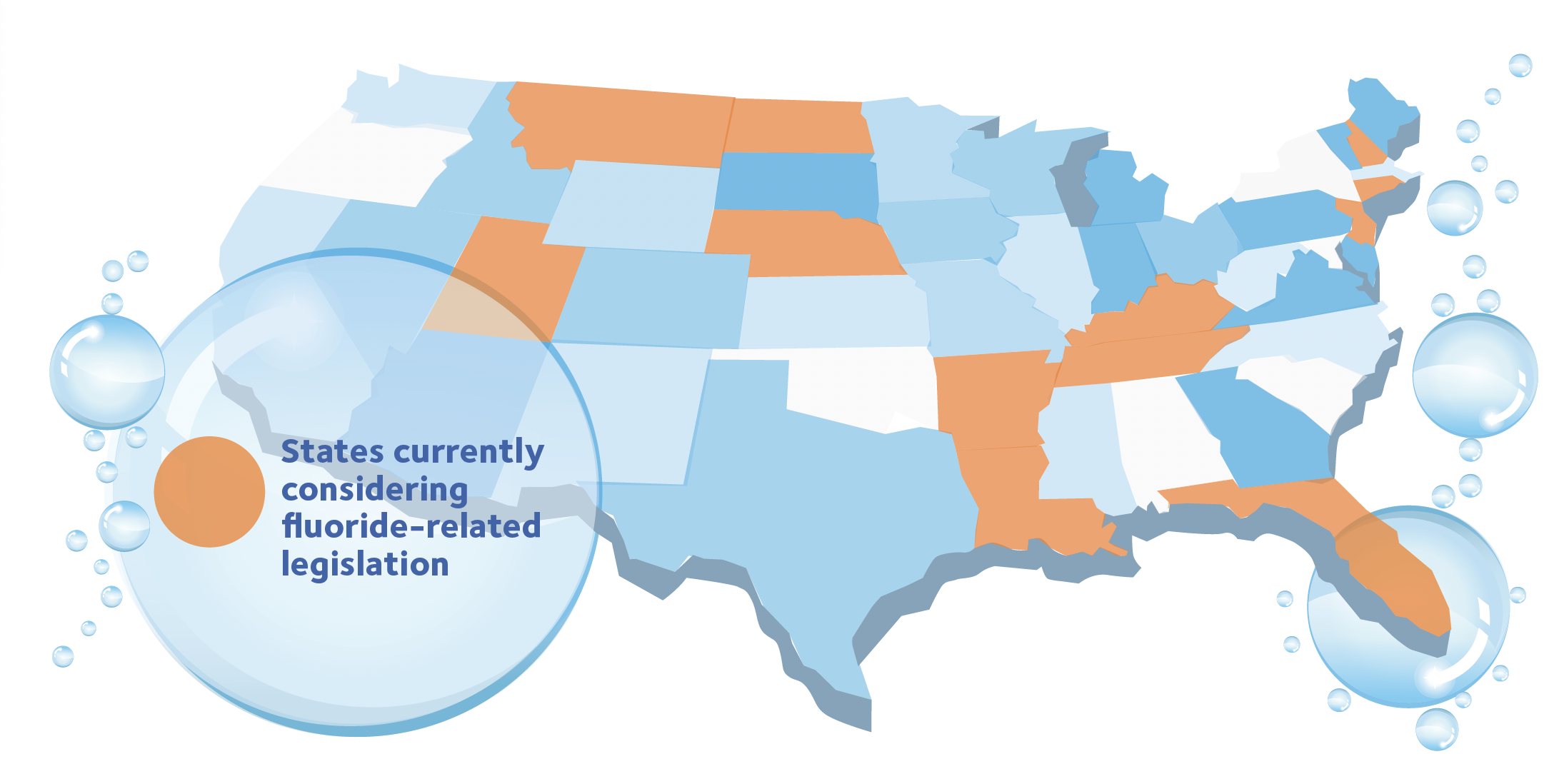What is the future of community water fluoridation?
A look at the national landscape

The topic of community water fluoridation has gained significant traction over the past few years — and not because of the long-held acknowledgement of its benefits.
Anti-fluoridation activists are continuing to claim the practice poses ethical and safety concerns, and many states are considering legislation that would ban adding fluoride to public water systems. Water fluoridation has been in practice for eight decades but it still continues to be debated, with most dental experts supporting it as a safe and effective way to prevent tooth decay.
According to a study from the ADA’s Health Policy Institute, the majority of dentists either “strongly support” or “somewhat support” community water fluoridation as a public health measure. Eighty-two percent of polled dentists expressed strong support, 10% said they “somewhat support” the practice, and only 5% said they “somewhat oppose” or “strongly oppose” the practice.
The ADA sent a letter March 5 to Robert F. Kennedy Jr., secretary of the U.S. Department of Health and Human Services, reiterating its staunch support for community water fluoridation. The letter emphasized that the ADA supports fluoridation at levels recommended by the U.S. Public Health Service, adding that “decades of rigorous, peer-reviewed scientific research have demonstrated that water fluoridation is a safe, effective and equitable method for preventing tooth decay across populations.”
Currently, community water fluoridation at optimal levels is defined as 0.7 parts per million by the Public Health Service. This is supported by the Centers for Disease Control and Prevention, the ADA and many leading public health authorities.
Although organizations like the ADA staunchly support fluoridation at optimal levels and most states are embracing the practice, others are considering removing fluoridation mandates or banning it altogether. Here is some of what’s going on at the state level, as of press time:
Positives for community water fluoridation
Connecticut: A bill has been introduced in the Connecticut Senate that ensures water fluoridation would continue at the current recommended level of 0.7 parts per million if the source of that recommendation, the U.S. Centers for Disease Control and Prevention drastically reduces its recommendation. If approved, Senate Bill 474 would ensure that consistent therapeutic contribution levels of fluoride would remain intact.
New Jersey: A bill has been introduced in the New Jersey Senate that would require statewide fluoridation of water supplied by community water systems. Known as the New Jersey Public Water Supply Fluoridation Act, Senate Bill 1179 would require the state’s environmental protection and health commissioners to adopt rules and regulations, including the means by which fluoride is controlled, the methods of testing the fluoride content and the records to be kept relating to fluoridation.
New Hampshire: The New Hampshire legislature rejected a bill that would have prohibited the addition of fluoride to public water systems. House Bill 691, which failed in a 14-2 vote, would have ended fluoridation in approximately 24 water systems, including the systems receiving water from neighboring water systems. Laurie Rosato, D.M.D., first vice-president of the New Hampshire Dental Society, spoke in opposition of the bill. Dr. Rosato is married to ADA President-elect Richard Rosato, D.M.D.
“Concord’s fluoridated water is helping make the difference between my young patients needing a regular cleaning, and my young patients needing extensive dental care,” Dr. Rosato said. “Fluoride is needed in the water. I see the proof of that every day in practice. What I have not seen, however, are examples of neurological disorders that are connected to the community water fluoridation, and we have the studies to prove that.”
Montana: A bill in Montana would have banned fluoridation of the state’s community water systems. House Bill 498, “An Act Prohibiting the Fluoridation of Public Water Supply Systems,” was introduced in February and tabled by the Human Services Committee. Having no further action this session, the bill is most likely dead.
North Dakota: A North Dakota bill that would have prohibited any form of fluoride to any public water supply failed in the House. “A person may not add or cause to be added any form of fluoride to any public water supply for the purpose of fluoridation, regardless of the intended concentration,” reads House Bill 1605, which failed in a 40-53 vote.
Negative proposals concerning water fluoridation
Arkansas: The Arkansas Senate rejected legislation that would have repealed the state’s fluoridation requirement. Senate Bill 2 would have removed the current law that requires systems serving 5,000 or more people to add fluoride to water systems. While the bill was defeated, the author also filed Senate Bill 282. It would establish countywide voting opportunities where voters may elect to prohibit fluoridation. The bill also would provide mechanisms for water operators to prohibit fluoridation, but the outcome of any public election, should one be held, would supersede the water operator’s prohibition.
Florida: If approved, Senate Bill 700 would eliminate fluoride from Florida’s public water supplies. While the measure does not explicitly mention fluoride, it prohibits water operators from using any additive that is intended primarily for health-related purposes. Additives that remove contaminants or increase water quality are exempt from this prohibition.
Kentucky: Kentucky’s House Bill 16 would make state water fluoridation programs optional, allowing water operators to decide whether to participate in water fluoridation programs. A failed amendment to the bill would have protected against expected increases in dental treatment costs to Medicaid if fluoridation ended. It would have directed water systems that end fluoridation to reimburse Medicaid for the increase in dental treatment costs as compared to the year prior to the prohibition. The bill remains dormant in the process.
Louisiana: Senate Bill 2 would prohibit the fluoridation of any public water system in Louisiana. Current law requires the Louisiana Department of Health to establish a water fluoridation program for public water systems with at least 5,000 service connections and provides exemptions for water systems that meet certain criteria, but the proposed bill would repeal the program.
Nebraska: Legislative Bill 147 would repeal Nebraska’s statewide fluoridation mandate and replace it with methods making fluoridation optional. Current law requires any localities that reach 1,000 or more residents to fluoridate unless an ordinance or referendum prevents it. The proposed law would allow public and private water supply entities to make the decision for themselves, so long as they adhere to the rules and regulations of the Department of Health and Human Services. The bill was introduced and referred to the Health and Human Services Committee.
Tennessee: If passed, Senate Bill 162 would prohibit public water system operators from adding fluoride to their water systems. The bill was introduced in January and has been referred to the Senate Energy, Agriculture and Natural Resources Committee. The bill has not moved as of yet.
Utah: On March 27, Utah became the first state to fully ban community water fluoridation. Gov. Spencer Cox signed House Bill 81 into law after it passed the House and Senate. Specifically, the bill prohibits adding fluoride to public water systems but allows a pharmacist to prescribe fluoride. In addition to sending its own letter, the ADA assisted the Utah Dental Association in deploying a Grassroots Action Alert asking dentists to urge Gov. Cox to veto the bill.
Education and accountability
Johnny Johnson, D.M.D., pediatric dentist, member of the ADA National Fluoridation Advisory Committee and president of the American Fluoridation Society, keeps tabs on cities and towns nationwide that are making decisions on whether to fluoridate their water. He said he has seen a great deal of anti-fluoridation activity in Wisconsin over the past few years, with anti-fluoride activists infiltrating communities and using intimidation tactics to further their narrative.
In DeForest, Wisconsin, a group of residents spoke strongly in support of fluoridation at a recent city council meeting and were targeted by a council member working with the anti-fluoride activists, according to Dr. Johnson. Deforest voted in February to remove fluoride from community drinking water.
“There is a lot of intimidation that goes on. Now they’re hitting Florida really, really hard,” Dr. Johnson said of the anti-fluoride activists.
Dr. Johnson encouraged those in communities targeted by anti-fluoride activists to submit open records requests, which allow public access to government agencies records under state public records laws. He said performing these requests can help keep government officials accountable.
“The overarching message is that they have become emboldened. When other communities are faced with these types of [threats], don’t hesitate to ask for emails and texts of the council members and include search terms,” Dr. Johnson said.
The ADA works with communities across the country to provide education and resources for these challenges, as well as works with the American Fluoridation Society, oral health coalitions and state associations.
Resources for dentists and patients
The ADA has resources to help dentists educate their patients on the benefits of community water fluoridation. For more information on the benefits of community water fluoridation, visit ADA.org/Fluoride.
The ADA revised its fluoridation brochure, called Fluoride: Nature’s Cavity Fighter. The eight-panel brochure reviews the benefits of fluoride, as well as the safety and effectiveness of community water fluoridation. It includes helpful images to show how much topical fluoride children should use, the recommended level of fluoride for drinking water, and discussions on how to know if your home water supply is fluoridated.



